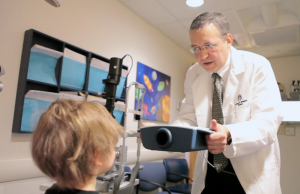Children with “lazy eye,” or amblyopia, have structurally intact eyes that may appear normal. But one eye isn’t used, generally because of a subtle misalignment. Unless someone notices this early enough, the “lazy” eye can slowly go blind, simply because the brain hasn’t received proper stimulation from it. It’s learned to ignore input from that eye.
“While amblyopia is easy to treat if you get to the kids early, it’s hard for us as ophthalmologists to get to the kids early because often the condition isn’t detected in the pediatric office,” says David Hunter, chief of ophthalmology at Children’s Hospital Boston.
Treatment consists of patching the sound eye, forcing the child to use the weaker eye. Ideally, this should be started before age 5, when the brain is still able to relearn; once a child reaches 8 to 10 years it’s often too late to restore his vision.
Over a decade ago, while at Johns Hopkins, Hunter came up with the idea of a device that would measure the eyes’ alignment and focusing ability by scanning the retinas as the child looks at a target (a small smiley face) and analyzing the light coming back from each eye.
He created a prototype of what’s now called the Pediatric Vision Scanner and tested it in children coming to his ophthalmology clinic at Children’s. It was able to detect well over 95 percent of children who had an eye problem. “No one’s ever seen that kind of accuracy in a screening device,” he says.
Hunter received support from Children’s Technology Development Fund, a Small Business Innovation Research grant, the National Eye Institute and private donors, and contracted with a team of engineers to build a handheld, lighter, more user-friendly version of original bulky device, more readily usable in pediatric offices and in community vision screening programs. He recently received FDA approval to start clinical trials.
Hunter’s mission is to make amblyopia screening for preschool-age children routine. Some states have mandated a full eye exam by eye specialists before entry to school, but this is expensive and may be too late to treat amblyopia successfully. Focusing on early amblyopia screening would be less expensive, Hunter says, and could reach more children.
For more, watch this video. Also check out our related post suggesting there may be hope for older patients, too, in the form of Alzheimer’s drugs.







